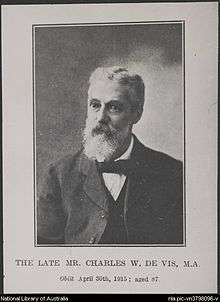Charles Walter De Vis

Charles Walter de Vis (Birmingham, England, 9 May 1829 – Brisbane, Queensland, Australia, 30 April 1915),[1] known as Devis before about 1882, was an English zoologist,[1] ornithologist.,[2] herpetologist,[1][3] and botanist.
De Vis gained a BA from Magdelene College, Cambridge in 1849, became a deacon in 1852, and was rector of Breane, Somerset from 1855-1859.[4] He gave up his ecclesiastical functions to devote himself to science, initially in England then after 1870 in Australia.[1] De Vis also wrote under the name of Thickthorn, the name of his home in Rockhampton.
He was a founder member of the Royal Society of Queensland of which he served as president in 1888-1889, and founder member and first vice-president of the Royal Australasian Ornithologists Union.[2]
His principal work concerned the fossil birds of Queensland (Darling Downs) and southern Australia (Cooper Creek),[2] but he also described a number of extant bird species. In fact, he was more successful at the latter, because due to insufficient knowledge of stratigraphy and evolution, he—like many ornithologists of his time—mistook subfossil remains of extant birds for the remains of extinct prehistoric species.
Among species he described were the white-winged robin in 1890, and the frill-necked monarch in 1895.[5]
De Vis also worked in the scientific field of herpetology, and he described many new species of reptiles.[1][3]
References
- 1 2 3 4 5 de Vis, Charles Walter (1829 - 1915) — Australian Dictionary of Biography
- 1 2 3 De Vis Charles Walter (1829 - 1915) — Encyclopedia of Australian science
- 1 2 The Reptile Database. www.reptile-database.org.
- ↑ Church of England, Central Board of Finance, Church Commissioners (1865). Crockford's Clerical Directory, 1865. Oxford University Press. p. 176 [17].
- ↑ Frill-necked Monarch (Arses lorealis) — The Internet Bird Collection
- ↑ IPNI. De Vis.
External links
- De Vis Charles Walter — Brisbane City Council Grave Location Search